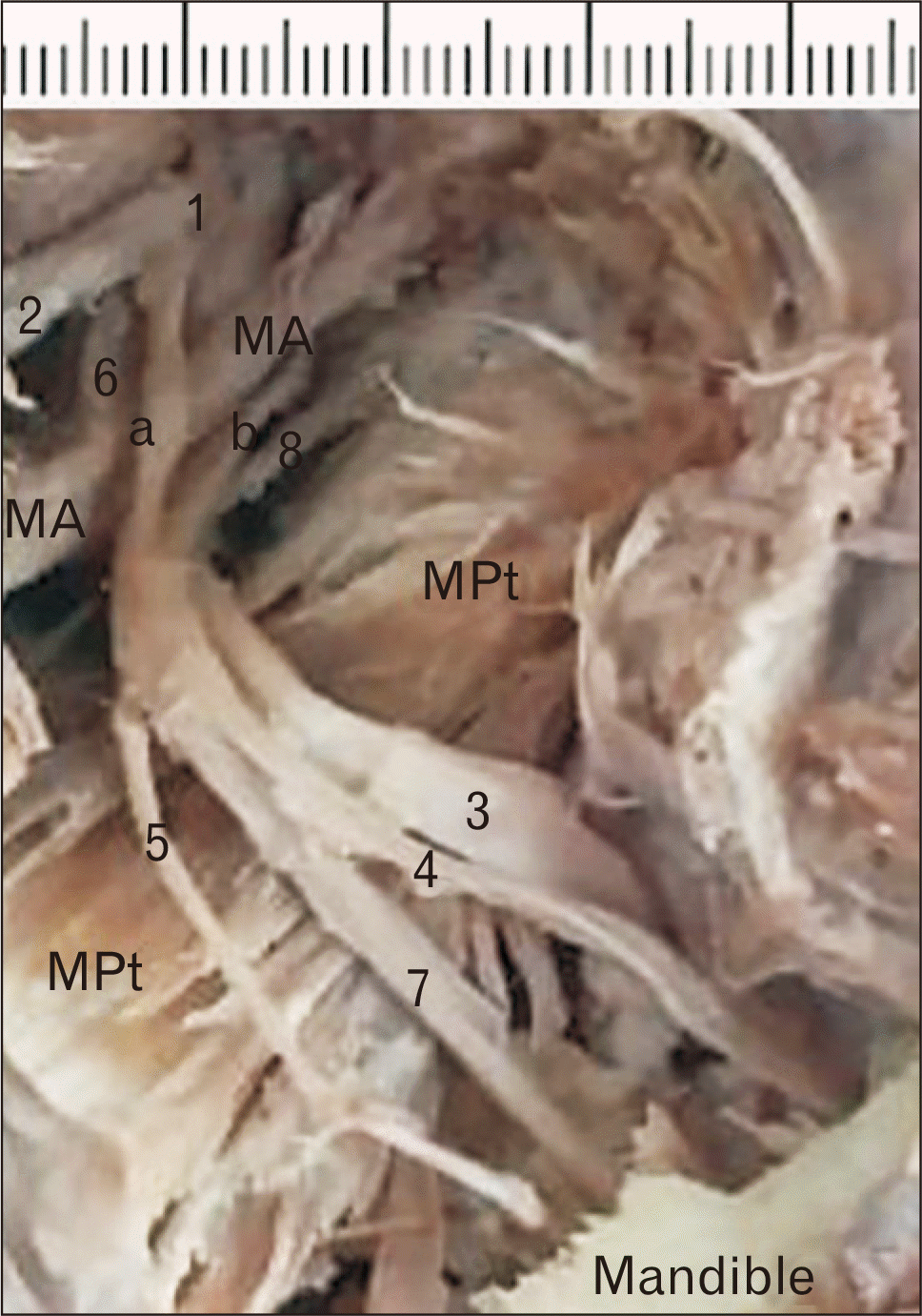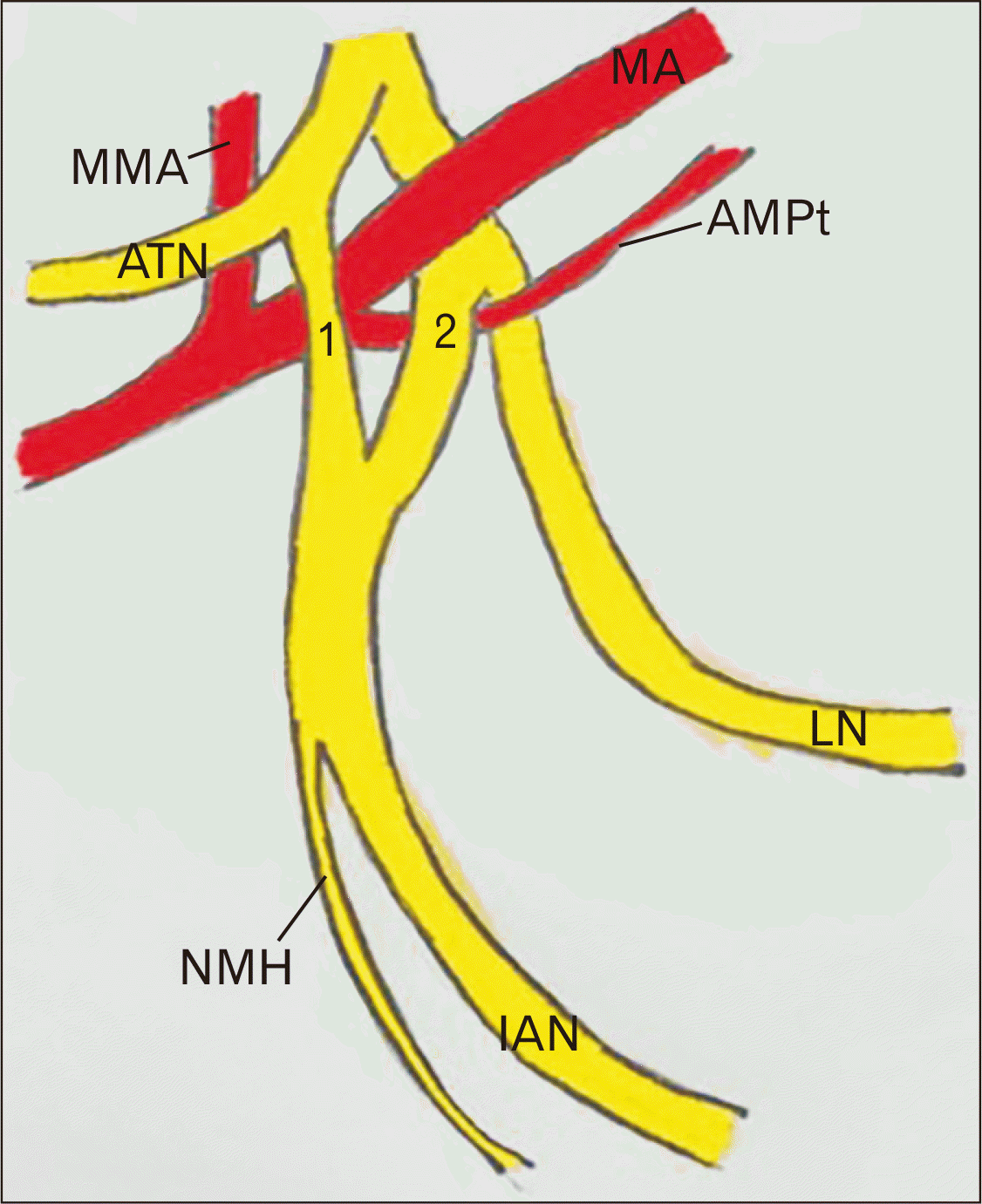1. Piagkou M, Demesticha T, Skandalakis P, Johnson EO. 2011; Functional anatomy of the mandibular nerve: consequences of nerve injury and entrapment. Clin Anat. 24:143–50. DOI:
10.1002/ca.21089. PMID:
21322036.

2. Anil A, Peker T, Turgut HB, Gülekon IN, Liman F. 2003; Variations in the anatomy of the inferior alveolar nerve. Br J Oral Maxillofac Surg. 41:236–9. DOI:
10.1016/S0266-4356(03)00113-X.
3. Fleury AA. 1990; Local anesthesia failure in endodontic therapy: the acute inflammation factor. Compendium. 11:210. 212. 214 passim.
5. Vreeland DL, Reader A, Beck M, Meyers W, Weaver J. 1989; An evaluation of volumes and concentrations of lidocaine in human inferior alveolar nerve block. J Endod. 15:6–12. DOI:
10.1016/S0099-2399(89)80091-3. PMID:
2607268.

7. Sumalatha S, Kotian SR, Thodeti H, Pandey AK, Fernandez RK, Nayak VS. 2018; Variations of the lingual and inferior alveolar nerves and their anomalous relationship with the maxillary artery. Eur J Anat. 22:403–10.
8. Krmpotić-Nemanić J, Vinter I, Hat J, Jalsovec D. 1999; Mandibular neuralgia due to anatomical variations. Eur Arch Otorhinolaryngol. 256:205–8. DOI:
10.1007/s004050050141. PMID:
10337513.

9. Calvin WH, Loeser JD, Howe JF. 1977; A neurophysiological theory for the pain mechanism of tic douloureux. Pain. 3:147–54. DOI:
10.1016/0304-3959(77)90078-1.

11. Khan MM, Darwish HH, Zaher WA. 2010; Perforation of the inferior alveolar nerve by the maxillary artery: an anatomical study. Br J Oral Maxillofac Surg. 48:645–7. DOI:
10.1016/j.bjoms.2009.11.002. PMID:
20018415.

12. Pai MM, Swamy RS, Prabhu LV. 2010; A variation in the morphology of the inferior alveolar nerve with potential clinical significance. Biomed Int. 1:93–5.
13. Quadros LS, Roy PA, D'souza AS. 2014; Inferior alveolar nerve with multiple roots. Br Biomed Bull. 2:26–30.
14. Dodd GD, Dolan PA, Ballantyne AJ, Ibanez ML, Chau P. 1970; The dissemination of tumors of the head and neck via the cranial nerves. Radiol Clin North Am. 8:445–61.
15. Pretterklieber ML, Skopakoff C, Mayr R. 1991; The human maxillary artery reinvestigated: I. topographical relations in the infratemporal fossa. Acta Anat (Basel). 142:281–7. DOI:
10.1159/000147203. PMID:
1801518.

16. Kalra S, Thamke S, Khandelwal A. 2014; An undocumented variation involving auriculotemporal nerve, inferior alveolar nerve and middle meningeal artery. Int J Res Med Sci. 2:1720–2. DOI:
10.5455/2320-6012.ijrms20141192.

17. Gülekon N, Anil A, Poyraz A, Peker T, Turgut HB, Karaköse M. 2005; Variations in the anatomy of the auriculotemporal nerve. Clin Anat. 18:15–22. DOI:
10.1002/ca.20068. PMID:
15597375.

18. Ortug G, Moriggl B. 1991; [The topography of the maxillary artery within the infratemporal fossa]. Anat Anz. 172:197–202. German.
19. Babu BP, Thomas H. 2018; Course of maxillary artery through loop of auriculotemporal nerve and deep to posterior division of mandibular nerve. Int J Adv Sci Eng Technol. 6:6–9.
20. Bronner-Fraser M. 1993; Environmental influences on neural crest cell migration. J Neurobiol. 24:233–47. DOI:
10.1002/neu.480240209. PMID:
8445389.

21. Tannahill D, Cook GM, Keynes RJ. 1997; Axon guidance and somites. Cell Tissue Res. 290:275–83. DOI:
10.1007/s004410050932. PMID:
9321689.

22. Sanes DH, Reh TA, Harris WA. 2000. Development of the nervous system. Academic Press;New York: p. 189–97.
23. Ranscht B, Bronner-Fraser M. 1991; T-cadherin expression alternates with migrating neural crest cells in the trunk of the avian embryo. Development. 111:15–22.

24. Debby-Brafman A, Burstyn-Cohen T, Klar A, Kalcheim C. 1999; F-Spondin, expressed in somite regions avoided by neural crest cells, mediates inhibition of distinct somite domains to neural crest migration. Neuron. 22:475–88. DOI:
10.1016/S0896-6273(00)80703-5. PMID:
10197528.

25. Roy TS, Sarkar AK, Panicker HK. 2002; Variation in the origin of the inferior alveolar nerve. Clin Anat. 15:143–7. DOI:
10.1002/ca.1110. PMID:
11877794.

26. Hogg ID, Stephens CB, Arnold GE. 1972; Theoretical anomalies of the stapedial artery. Ann Otol Rhinol Laryngol. 81:860–70. DOI:
10.1177/000348947208100619. PMID:
4673857.

27. Shalini R, RaviVarman C, Manoranjitham R, Veeramuthu M. 2016; Morphometric study on mandibular foramen and incidence of accessory mandibular foramen in mandibles of south Indian population and its clinical implications in inferior alveolar nerve block. Anat Cell Biol. 49:241–8. DOI:
10.5115/acb.2016.49.4.241. PMID:
28127498. PMCID:
PMC5266106.

29. Yu SK, Kim S, Kang SG, Kim JH, Lim KO, Hwang SI, Kim HJ. 2015; Morphological assessment of the anterior loop of the mandibular canal in Koreans. Anat Cell Biol. 48:75–80. DOI:
10.5115/acb.2015.48.1.75. PMID:
25806125. PMCID:
PMC4371184.







 PDF
PDF Citation
Citation Print
Print



 XML Download
XML Download